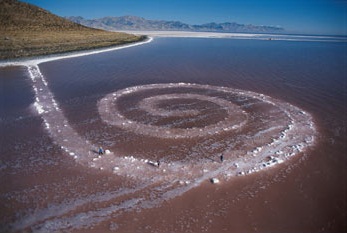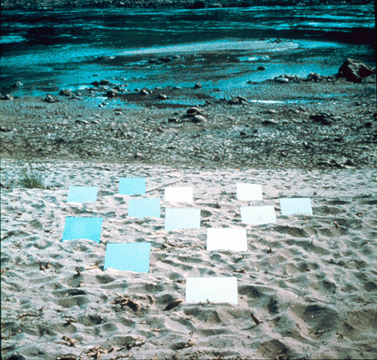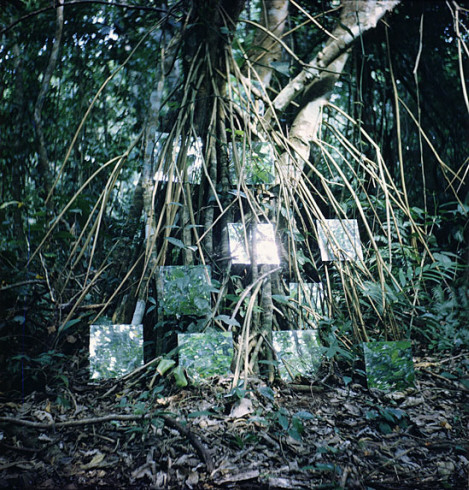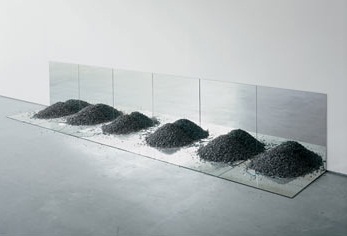<Back to Index>
- Land Artist Robert Smithson, 1938
PAGE SPONSOR
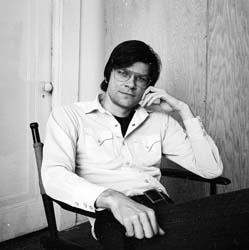
Robert Smithson (January 2, 1938 - July 20, 1973) was an American artist famous for his land art.
Smithson was born in Passaic, New Jersey, and studied painting and drawing in New York City at the Art Students League of New York.
His early exhibited artworks were collage works influenced by "homoerotic drawings and clippings from beefcake magazines", science fiction and early Pop Art. He primarily identified himself as a painter during this time, but after a three year rest from the art world, Smithson emerged in 1964 as a proponent of the emerging minimalist movement. His new work abandoned the preoccupation with the body that had been common in his earlier work. Instead he began to use glass sheet and neon lighting tubes to explore visual refraction and mirroring, in particular the sculpture Enantiomorphic Chambers. Crystalline structures and the concept of entropy became of particular interest to him, and informed a number of sculptures completed during this period, including Alogon 2. Smithson became affiliated with artists who were identified with the minimalist or Primary Structures movement, such as Nancy Holt (whom he married), Robert Morris and Sol LeWitt. As a writer, Smithson was interested in applying mathematical impersonality to art that he outlined in essays and reviews for Arts Magazine and Artforum and for a period was better known as a critic than as an artist. Some of Smithson's later writings recovered 18th and 19th century conceptions of landscape architecture which influenced the pivotal earthwork explorations which characterized his later work. He eventually joined the Dwan Gallery, whose owner Virginia Dwan was an enthusiastic supporter of his work.
In 1967 Smithson began exploring industrial areas around New Jersey and was fascinated by the sight of dump trucks excavating tons of earth and rock that he described in an essay as the equivalents of the monuments of antiquity. This resulted in the series of 'non - sites' in which earth and rocks collected from a specific area are installed in the gallery as sculptures, often combined with mirrors or glass. In September 1968, Smithson published the essay "A Sedimentation of the Mind: Earth Projects" in Artforum that promoted the work of the first wave of land art artists, and in 1969 he began producing land art pieces to further explore concepts gained from his readings of William S. Burroughs, J.G. Ballard and George Kubler.
As well as works of art, Smithson produced a good deal of theoretical and critical writing, including the 2D paper work A Heap of Language, which sought to show how writing might become an artwork. In his essay "Incidents of Mirror - Travel in the Yucatan" Smithson documents a series of temporary sculptures made with mirrors at particular locations around the Yucatan peninsula. Part travelogue, part critical rumination, the article highlights Smithson's concern with the temporal as a cornerstone of his work.
Smithson's interest in the temporal is explored in his writings in part through the recovery of the ideas of the picturesque. His essay "Frederick Law Olmsted and the Dialectical Landscape" was written in 1973 after Smithson had seen an exhibition curated by Elizabeth Barlow Rogers at the Whitney Museum entitled “Frederick Law Olmsted’s New York” as the cultural and temporal context for the creation of his late 19th century design for Central Park. In examining the photographs of the land set aside to become Central Park, Smithson saw the barren landscape that had been degraded by humans before Olmsted constructed the complex ‘naturalistic’ landscape that was viscerally apparent to New Yorkers in the 1970s. Smithson was interested in challenging the prevalent conception of Central Park as an outdated 19th century Picturesque aesthetic in landscape architecture that had a static relationship within the continuously evolving urban fabric of New York City. In studying the writings of 18th and 19th century Picturesque treatise writers Gilpin, Price, Knight and Whately, Smithson recovers issues of site specificity and human intervention as dialectic landscape layers, experiential multiplicity, and the value of deformations manifest in the Picturesque landscape.
Smithson further implies in this essay that what distinguishes the Picturesque is that it is based on real land. For Smithson, a park exists as “a process of ongoing relationships existing in a physical region”. Smithson was interested in Central Park as a landscape which by the 1970s had weathered and grown as Olmsted’s creation, but was layered with new evidence of human intervention.
Now the Ramble has grown up into an urban jungle, and lurking in its thickets are “hoods, hobos, hustlers, and homosexuals,” and other estranged creatures of the city…. Walking east, I passed graffiti on boulders… On the base of the Obelisk along with the hieroglyphs there are also graffiti. …In the spillway that pours out of the Wollman Memorial Ice Rink, I noticed a metal grocery cart and a trash basket half - submerged in the water. Further down, the spillway becomes a brook choked with mud and tin cans. The mud then spews under the Gapstow Bridge to become a muddy slough that inundates a good part of The Pond, leaving the rest of The Pond aswirl with oil slicks, sludge, and Dixie cups”
While Smithson did not find “beauty” in the evidence of abuse and neglect, he did see the state of things as demonstrative of the continually transforming relationships between man and landscape. In his proposal to make process art out of the dredging of The Pond, Smithson sought to insert himself into the dynamic evolution of the park.
Smithson became particularly interested in the notion of deformities within the spectrum of anti - aesthetic dynamic relationships which he saw present in the Picturesque landscape. He claimed, “the best sites for ‘earth art’ are sites that have been disrupted by industry, reckless urbanization, or nature’s own devastation.” While in earlier 18th century formal characterizations of the pastoral and the sublime, something like a “gash in the ground” if encountered by a “leveling improver”, as described by Price, would have been smoothed over and the whole composition returned to a more aesthetically pleasing contour. For Smithson, however, it was not necessary that the deformation become a visual aspect of a landscape; by his anti - formalist logic, more important was the temporal scar worked over by natural or human intervention. He saw parallels to Olmsted's Central Park as a “sylvan” green overlay on the depleted landscape that preceded his Central Park. Defending himself against allegations that he and other earth artists “cut and gouge the land like Army engineers”, Smithson, in his own essay, charges that one of such opinions “failed to recognize the possibility of a direct organic manipulation of the land..” and would “turn his back on the contradictions that inhabit our landscapes”.
In revisiting the 18th and early 19th century treatises of the Picturesque, which Olmsted interpreted in his practice, Smithson exposes threads of an anti - aesthetic anti - formalist logic and a theoretical framework of the Picturesque that addressed the dialectic between the physical landscape and its temporal context. By re-interpreting and re-valuing these treatises, Smithson was able to broaden the temporal and intellectual context for his own work, and to offer renewed meaning for Central Park as an important work of modern art and landscape architecture.
Other theoretical writings explore the relationship of a piece of art to its environment, from which he developed his concept of sites and non - sites. A site was a work located in a specific outdoor location, while a non - site was a work which could be displayed in any suitable space, such as an art gallery. Spiral Jetty is an example of a sited work, while Smithson's non - site pieces frequently consist of photographs of a particular location, often exhibited alongside some material (such as stones or soil) removed from that location.
The journeys he undertook were central to his practice as an artist, and his non - site sculptures often included maps and aerial photos of a particular location, as well as the geological artifacts displaced from those sites. In 1970 at Kent State University, Smithson created Partially Buried Woodshed (1970) to illustrate geological time consuming human history. His most famous work is Spiral Jetty (1970), a 1,500 foot (460 m) long spiral - shaped jetty extending into the Great Salt Lake in Utah constructed from rocks, earth and salt. It was entirely submerged by rising lake waters for several years, but has since reemerged. The lake waters may be pinkish due to high concentrations of β-carotene in the halophyte green alga Dunaliella salina.
In 1971 he created Broken circle / Spiral Hill for the exhibition for the Sonsbeek '71 art festival at Emmen, the Netherlands. The subject of the 1971 Sonsbeek exhibition was Beyond Lawn and Order (Dutch: Buiten de perken).
On July 20, 1973, Smithson died in a plane crash, while surveying sites for his work Amarillo Ramp in Texas. Despite his early death, and relatively few surviving major works, Smithson has a following among many contemporary artists. In recent years, Tacita Dean, Sam Durant, Lee Ranaldo, Vik Muniz, Mike Nelson, and the Bruce High Quality Foundation have all made homages to Smithson's works.
The Estate of Robert Smithson is managed by James Cohan Gallery.
